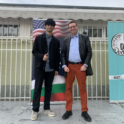StoriesBack to Stories
Volunteering at NTA School for Refugee Children
By Kara T., YES Abroad 2016-2017, Malaysia
The NTA School for Refugee Children was founded in 2012 and is located in Alor Setar, Kedah. 95% of the children that attend this school are from the Rohingya refugee community in the Kota Setar region of Kedah, Malaysia. This is the school where I have been lucky enough to volunteer every Wednesday for the past two months.
I still remember the first meeting I had with the school’s principal to discuss what I would be doing as a volunteer. Prior to arriving at the school for the first time, I pictured the school to be the same as any other government funded primary school: multiple buildings with several classrooms and teachers. I was surprised when I arrived at the school for the first time, and saw that the entire school was essentially the size of a studio flat with only two classrooms and two teachers.
The school principal and her husband explained to me that they decided to found this school after realizing the gap in education programs for refugees. Children with refugee status are not officially recognized in Malaysia and therefore, cannot enter government schools. The principal and her husband then explained that the parents of these refugees would go knocking door to door with money asking anybody they knew if they could teach their children. After realizing that there was a dire need for a school for these refugee children, the couple decided to found the NTA School for Refugee Children. This school has become sponsored by the United Nations and many other local Malaysian communities. I was, and still am, amazed by this couple’s commitment and kindness.
Unfortunately, this school only teaches students until the age of 12. Normally, a Malaysian student would enter secondary school after completing primary school. However, many of the refugee children are not at the level where they can enter a government funded secondary school, so their education typically ends at age 12. The school’s principal also explained that many of the girls may become much more disadvantaged within society as soon as their education at this school ends.
After talking to the principal of this school for a while, we finally figured out a schedule. I would come in every Wednesday to help the teacher of the older class teach English and science. Before leaving, I got to say hello to all the children. I could not wait to start the next Wednesday.
In preparation for my first day of volunteering, I borrowed some English story books from the library and put together a lesson about parts of a plant as well as an English vocabulary lesson. I did not really expect to use the lessons I had prepared, because I assumed that I was going to primarily be a teachers’ helper, assisting when the teacher called on me. But when I walked into the school my first day and the teacher said, “Okay Kara, the whole day is yours. Teach whatever you like,” my first reaction was to laugh, because I did not fully believe her. The teacher quickly reassured me and told me she would be there to help whenever I needed. So I took a deep breath and dove right in.
I spent the whole day teaching the lessons I had prepared, granted with a lot of help from the other teacher. At the end of the day when I quizzed the students on what I taught, I saw that they did actually understand me and my Bahasa Malaysia skills, and that has become one of my proudest moments. When I left that first day, all the students said “goodbye teacher Kara” and I couldn’t stop smiling. Since that first week, I have relaxed into teaching and look forward to Wednesday every week. My favorite thing to do with the kids are science labs. So far we have planted seeds, made ice cream, and constructed the three phases of water!
Even though these children have fewer socioeconomic means, they still have incredible energy and thirst for knowledge. I get to see their eyes light up every time I teach them something new. These kids mean so much to me, and I hope one day they will have the same opportunities as Malaysian children and children around the world.





